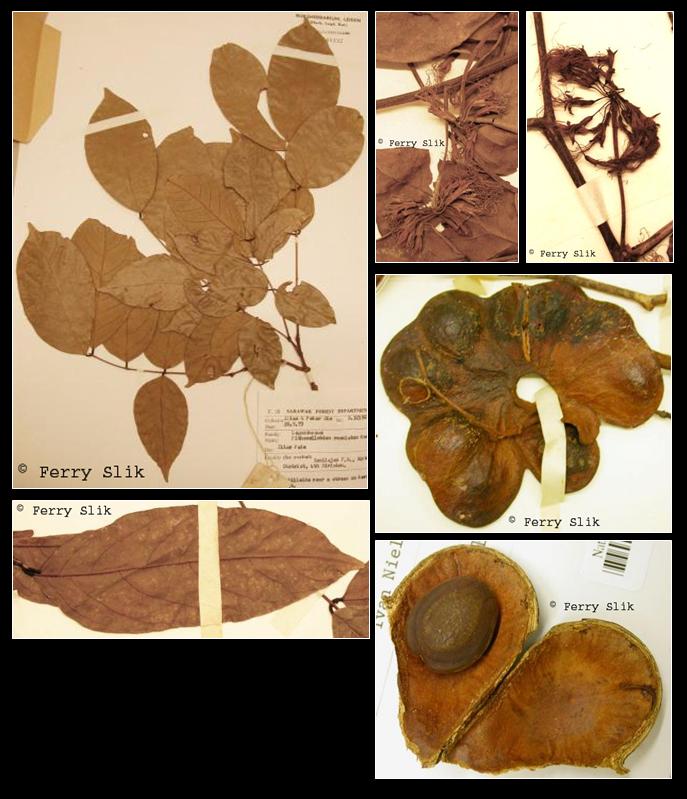Albizia rosulata (Kosterm.) Nielsen, Opera Bot. 81 (1985)
Latin for 'rose-like'?Synonyms
Parasamanea landakensis (Kosterm.) Kosterm.
Parenterolobium rosulatum (Kosterm.) Kosterm.
Pithecellobium landakensis Kosterm.
Pithecellobium rosulatum Kosterm.
Description
Tree to 64 m high, d.b.h. to 65(-94) cm; buttresses often present, low and rounded to 30 by 30 cm;
bark usually rough, brown to blackish, peeling off irregularly in rather large
pieces, mottled yellow and black. Inner bark red to brown. Sapwood ochre to pale yellowish white or
white; heartwood blackish brown, streaked. Branchlets terete, puberulous
in the ultimate parts, glabrescent. Stipules triangular, acute, rigid, to c. 1 mm, caducous.
Leaves: petiole 0.9-2.5 cm, short-puberulous, glabrescent, with a gland c. 1 mm below the junctions
of the pinnae, subsessile or raised, rimmed, concave, when narrow with an orifice, 0.5-1.2
mm in diameter; pinnae 1 pair, puberulous, glabrescent, 6-18.5 cm, with glands at the junctions
of the petiolules, stalked, narrower but in other aspects similar to the petiolar gland; petiolules 2-6
mm, puberulous, glabrescent; leaflets (2-)3-4 pairs per pinna, (sub)opposite, charlaceous, ¡À unequal-
sided, ovate to oblong, (3-)4-15 by 1.7-6.3 cm, glabrescent, or lower surface with scattered
glandular hairs; base ¡À symmetrically cuneate, apex acuminate; main vein central or subcentral.
Inflorescence composed of pedunculate solitary corymbs, placed in the axils of the developing
leaves or on short lateral branchlets developing simultaneously with the leaves; peduncles 1.8-5.5
cm, densely puberulous, corymb consisting of up to c. 25 pedicellate flowers. Flowers dimorphic,
pentamerous, bisexual; pedicel 3-5(-8.5) mm. Calyx green or pale green, cup-shaped, 1.5-2.5
(-3) mm, teeth triangular, acute, to 0.5 mm, puberulous at the apex. Corolla pale green or greenish
white, funnel-shaped, glabrous at base, 5-8(-9) mm; lobes oblong, acute, puberulous toward
the top, 1.5-2.5(-3.5) mm. Stamens white, c. 20 mm, tube equalling the corolla-tube. Ovary sessile,
glabrous, c. 3 mm. Pod black or brownish black, woody, curved into a circle, c. 10 cm in diameter,
ventral suture forming the outer margin, segmented, segments 1 -seeded, subtriangular, c. 2-3 cm
wide in the outer part, glabrous, indehiscent, the pod falling apart in segments. Seeds brown-black,
ovoid, often irregularly shaped, flattened, c. 16-19 by 14-17 by 7-8 mm; areole horseshoe-shaped,
continuous between both faces of the seed, c. 1-2 mm wide, closed, central part of seed with a cracked
testa. [from Flora Malesiana]
Ecology
Primary rain forest on sandy loam soil, sandy clay, in kerangas, peatswamp
forest, or riverine forest; locally said to be common on top and upper slopes of ridges; altitude
c. 0-100(-750) m.
Distribution
Borneo.
Local names
Borneo: Arak-arak, Berayung, Girik hitam, Gurak, Jaring, Jaring hantu, Jering hutan,
Kelupit, Kumin muroh, Merbau lalot.
